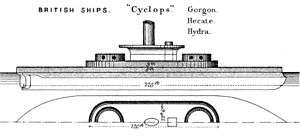HMS Hecate (1871)
 Right elevation plan from Brassey's Naval Annual 1888–1889 | |
| History | |
|---|---|
| Name: | HMS Hecate |
| Namesake: | Hecate |
| Builder: | J & W Dudgeon, Cubitt Town, London |
| Cost: | £156,782 |
| Laid down: | 5 September 1870 |
| Launched: | 30 September 1871 |
| Completed: | 24 May 1877 |
| Commissioned: | April 1872 |
| Out of service: | 1901 |
| Refit: | 1885–86 |
| Fate: | Sold for scrap 12 May 1903 |
| General characteristics | |
| Class and type: | Cyclops-class breastwork monitor |
| Displacement: | 3,480 long tons (3,540 t) |
| Length: | 225 ft (68.6 m) (p/p) |
| Beam: | 45 ft (13.7 m) |
| Draught: | 16 ft 3 in (5.0 m) (deep load) |
| Installed power: | 1,579 ihp (1,177 kW) |
| Propulsion: | 2 shafts, 2 inverted compound steam engines |
| Speed: | 10.5 knots (19.4 km/h; 12.1 mph) |
| Range: | 3,000 nmi (5,600 km; 3,500 mi) at 10 kn (19 km/h; 12 mph) |
| Complement: | 156 |
| Armament: | 2 × twin 10-inch rifled muzzle loaders |
| Armour: |
|
HMS Hecate was the last ship completed of the four Cyclops-class breastwork monitors built for the Royal Navy during the 1870s.
Design and description
The Cyclops-class ships were modified versions of the Cerberus class.[1] The ships had a length between perpendiculars of 225 feet (68.6 m), a beam of 45 feet (13.7 m), and a draught of 16 feet 3 inches (4.95 m) at deep load. They displaced 3,480 long tons (3,540 t). Their crew consisted of 156 officers and men.[2] Hydra had two 4-cylinder inverted compound steam engines, each driving a single propeller shaft. The engines produced a total of 1,472 indicated horsepower (1,098 kW) during the ship's sea trials which gave her a maximum speed of 11.2 knots (20.7 km/h; 12.9 mph). The ships carried 250 long tons (250 t) of coal,[3] enough to steam 3,000 nautical miles (5,600 km; 3,500 mi) at 10 knots (19 km/h; 12 mph).[4]
The ships mounted four 10-inch rifled muzzle-loading guns in twin-gun turrets fore and aft of the superstructure. The guns could fire both solid shot and explosive shells.[5] They were mounted on carriages that used hydraulic jacks to elevate and depress the guns.[6]
The Cyclops class had a complete waterline belt of wrought iron that was 8 inches (203 mm) thick amidships and thinned to 6 inches (152 mm) at the ends. The superstructure and conning tower was fully armoured, the reason it was called a breastwork, with 8–9 inches (203–229 mm) of wrought iron. The gun turrets had 10 inches on their faces and 9 inches on the sides and rear. All of the vertical armour was backed by 9–11 inches (229–279 mm) of teak. The decks were 1.5 inches (38.1 mm) thick.[7]
Construction
Together with her sister ships, Cyclops and Gorgon, she was placed on the non-effective list of ships in January 1902,[8] and sold for scrap the following year.
References
- Ballard, G. A., Admiral (1980). The Black Battlefleet. Annapolis, MD: Naval Institute Press. ISBN 0-87021-924-3.
- Gardiner, Robert, ed. (1979). Conway's All the World's Fighting Ships 1860–1905. Greenwich: Conway Maritime Press. ISBN 0-8317-0302-4.
- Parkes, Oscar (1990). British Battleships (reprint of the 1957 ed.). Annapolis, MD: Naval Institute Press. ISBN 1-55750-075-4.
- Silverstone, Paul H. (1984). Directory of the World's Capital Ships. New York: Hippocrene Books. ISBN 0-88254-979-0.